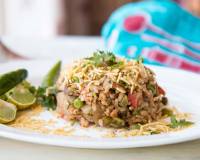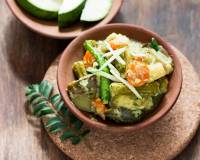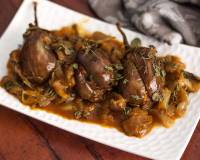Kathirikai Urulai Kizhangu Pachadi Recipe | Brinjal & Potato Dal
Enjoy this hearty Kathirikai Urulai Kizhangu Pachadi recipe with brinjal, potato & moong dal. Satisfying, healthy & perfect for any South Indian meal.

In this Kathirikai Urulai Kizhangu Pachadi Recipe, tender brinjal (eggplant) and potato pieces are simmered in a creamy moong dal base, delivering a comforting, mildly spiced South Indian dish. Originating from Tamil Nadu cuisine, it’s packed with vibrant flavors—from the earthy aroma of curry leaves and mustard seeds to the tangy sweetness of tomatoes.
This recipe is perfect any time of year since brinjal and potatoes are widely available year-round. Moong dal is known for its high protein content and easy digestibility, making this a nourishing choice for both everyday meals and festive gatherings.
Pair it with hot steamed rice, Phulka, a Beetroot Poriyal to create a wholesome, delicious spread. The personal twist in this recipe includes adding optional sambar powder or a hint of tamarind for extra depth.
If you like this recipe, you can also try other Dal recipes such as
10 M
30 M
40 M
4 Servings
Ingredients
-
For the dal
- 1/2 cup Yellow Moong Dal (Split) , soaked for 15 minutes
- 1/2 teaspoon Turmeric powder (Haldi)
- 2 cups Water , for pressure cooking For the Vegetables & Aromatics
- 1/2 cup Pearl onions (Sambar Onions) , finely chopped
- 1 Tomato , finely chopped
- 4 Small Brinjal (Baingan / Eggplant) , diced
- 1 Potatoes (Aloo) , diced
- 3 Green Chillies , finely chopped Spices & Seasoning
- 1/2 teaspoon Salt , adjust to taste
- 1/4 teaspoon Asafoetida (hing)
- 1/2 teaspoon Sambar Powder , optional (for extra flavour)
- 1 tablespoon Tamarind Paste , optional (for extra tang) For tempering
- 1 tablespoon Oil
- 1/2 teaspoon Mustard seeds (Rai/ Kadugu)
- 1 teaspoon White Urad Dal (Split)
- 1 sprig Curry leaves , roughly torn
- 2 Dry Red Chillies For Garnish
- Coriander (Dhania) Leaves , a handful (chopped)
How to make Kathirikai Urulai Kizhangu Pachadi Recipe | Brinjal & Potato Dal
To begin making the Kathirikai Urulai Kizhangu Pachadi recipe, prepare all the ingredients and keep them ready.
First step is to pressure-cook the dal. Rinse and drain the soaked moong dal.
In a pressure cooker, combine the dal with 2 cups of water and ½ teaspoon turmeric powder. Cook for about 3 whistles on medium flame and turn off the heat. Let the pressure release naturally.
Once done, open the cooker and mash the dal into a smooth paste. Keep aside.
Heat oil in a medium-sized pan over medium flame. Add mustard seeds, urad dal, dry red chillies, and curry leaves.
Allow the mustard seeds to splutter and the urad dal to turn golden, enhancing the aroma of your Pachadi recipe.
Stir in the chopped onions and sauté until they become translucent. Add the chopped tomatoes, green chillies, and a little more turmeric if desired.
Cook until the tomatoes soften and release their juices. Gently add cubed potatoes and brinjal, tossing them with the onion-tomato mixture.
If using, sprinkle asafoetida, red chili powder or sambar powder, and tamarind extract for additional flavor.
Reduce the flame slightly, add 1/4 cup of water and cook for about 5–7 minutes, or until the vegetables begin to turn tender.
Pour the mashed moong dal over the vegetables. Add a little water to achieve a gravy like consistency. Stir well.
Season with salt and let the Pachadi come to a gentle boil. Lower the heat and simmer for about 5 minutes, allowing all the flavors to meld. Switch off the flame and top with fresh coriander leaves and transfer to a serving bowl.
Serve this comforting Kathirikai Urulai Kizhangu Pachadi Recipe hot with Steamed rice, Phulka, a Beetroot Poriyal as part of a South Indian meal.
Tips & Variations
Ingredient Swaps: Carrots, peas, or bell peppers can be added for extra color and nutrition.
Kids’ Lunch Box: Keep the consistency slightly thicker to prevent spills; pair with rice or rotis.
Party Upgrade: Enhance with extra sambar powder or a pinch of garam masala. Top with fried onions for a richer presentation.
Dietary Notes: This dish is vegan and can be made gluten-free by ensuring your asafoetida is certified gluten-free.








